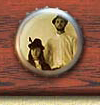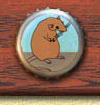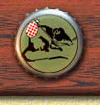THE GLASS COLLECTION
Intro • Germany • Netherlands • Belgium • USA • Others
![]()
Traditional Bavarian "Mass"

For all those who have ever visited the province of Bavaria in southern Germany, this glass should look very familiar. In the warm summer months, it can be found out in the famous shady beer gardens where it is filled with one liter of light-colored refreshing beer. In the cooler months of winter, the beer changes color to the darker hues of the thick, high-alcohol, festive beers found in abundance in the long beer halls. The drinking songs remain the same the whole year through, however.
The Munich breweries



Augustiner Bräu, Paulanerbräu, Spaten-Franziskaner-Bräu, Hacker-Pschorr Bräu, Löwenbräu and Hofbräu are the major breweries that have established themselves in Munich, home of the famous Oktoberfest. The giant brewery buildings find themselves either directly in or very close to the heart of the city. They offer a wide assortment of beers, ranging from 0% alcohol-free beer to 7.5% dark strong beers.
Oktoberfest vessels

"Greetings from Oktoberfest" are the words that decorate this half-liter sturdy ceramic mug. The mug depicts the typical attire, decorations and colors (including the white-blue pattern), attractions, food, and of course beer. All the major brewery names are shown on the balloons. Hackerbräu and Pschorr Bräu have merged but are still depicted as seperate breweries here.
The very first Oktoberfest was a one day celebration and took place in the form of a horserace on 17 October 1810 in order to celebrate the marriage of crown prince Ludwig with princess Therese von Sachsen Hildburghausen. By 1818, rides and beer started to appear. By 1829, the celebration had been extended to its current 16 day length, which starts in September and ends on the first Sunday in October.

This half-liter sized glass was generously donated by a liquor store in Dachau, a city not too far from Munich. This 1994 glass from Spaten-Franziskaner-Bräu is meant to hold their Oktoberfestbier (an amber beer known as a märzen). The beer was first brewed in 1872.
It shows a typical Oktoberfest band wearing the traditonal lederhosen outfits and thick felt hats. The green wreath is commonly found decorating the many celebration beer halls. Again note the white-blue pattern of the decorations.
The brewery was founded in 1397 and taken over by Gabriel Sedlmayer in 1807 (note the initials on the berwery symbol). In 1851, his sons took over the Franziskaner Leistbrauerei. In 1922, both brew sites merged. Spaten means 'spade' in German, and the brewery symbol is a malt shovel.
Früh Kölsch glass

Kölsch beer is a speciality brewed only in and around Köln (Cologne). The Colner Hofbräu, in Früh offers this superb example of a proper Kölsch glass. The glass is very thin walled and feels light and delicate in the hand, even with beer inside. In cafés and pubs of the area, dozens of tiny glasses are served simultaneously from carrying special trays.
Lauterbacher glass

This half-liter sized glass by Brauerei L. Ehnle was meant for their delicious Weizenbier (German style wheat beer). The tall glass is wider at the top than at the base in order to deal with the very foamy and creamy white head of the hazy golden beer. Throughout the glass is a lovely twisting effect.
The logo is of a traditonal brewing barrel and equipment. Colorful hops and barley provide decoration. On the barrel are the dates 1889 - 1989, making this a centennial celebration glass. "Lauterbacher" refers to Lauterbach, the city in which the brewery is located in southern Germany.
Heureka ceramic cup
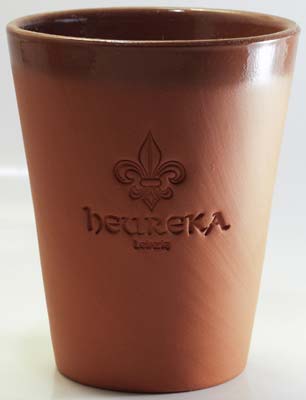
This cup was acquired during a large city festival in Dresden, located near the borders of Poland and the Czech Republic. The main market square was filled with a wide variety of stands selling food, beer, liquor and trinkets. Many vendors wore medieval outfits, and the whole area had an atmosphere of several centuries ago.
Beer was served in this ceramic 40 cl. cup, which is fully glazed on the inside to prevent the liquid from soaking through, but the outside still retains the nice rough texture of the red clay. It is extremely wide, even at the base, and is a bit difficult for those with somewhat smaller hands. Pressed into the clay is the decorative image of a fleur-de-lis, the word 'Heureka', and the city name 'Leipzig'. Presumably this has to do with where the cup was made.
Ureich glass

This 0.3 liter sized glass is a designed to hold Ureich (with Ur meaning old and eich meaning oak), a pilsener beer from Eichbaum-Brauerein, in Mannheim. The glass is silver-rimmed and depicts the brewery's logo: an oak tree (or "Eichbaum" in German) wreathed by hops and barley.
The shape of the glass is based on the old German drinking horn. Unlike those actual horns of the past, however, the Ureich glass has a stem of solid glass (which makes for easy cleaning) and a large round glass disk attached to the bottom of the glass (which allows one to set the glass down and not have to gulp the whole beer at once).
Thurn & Taxis shot glass

While this tiny gold-rimmed shot glass may not be intended as a beer glass, the dark blue logo is the symbol of the Fürstliche Brauerei Thurn & Taxis, a large brewery in the beautiful city of Regensburg. Both Thurn and Taxis were prominent royal families in the Bavarian region and had control over many different areas, including the post office.
Aventinus glass

Aventinus is a Weizenstarkbier (wheat strong beer) brewed by Privatbrauerei G. Schneider und Sohn KG in Kelheim, a charming city in the southern province of Bavaria. While the shape of this half-liter glass is based closely on the typical German wheat beer glass, it is slightly more angular in appearance. The glass fits firmly in one's hand and has a nice solid base... probably a good idea when one considers that the beer to be consumed from the glass is 8% alcohol.
The most unsual feature of the glass, however, is the location of the logo. It is found on the stem instead of on the the bowl as is most common. The center picture is of a well-dressed man writing in a book, presumably Aventinus himself. Above the picture is the brewery logo, surrounded by drawings of hops and barley in gold.
Hansa glasses

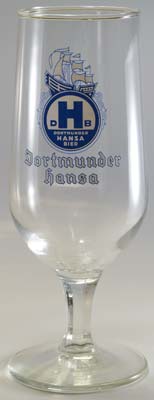
The 0.25 glass on the left is designed to hold the brewery's pilsener. While it may first appear that the glass is cracked, it is actually just textured. It feels smooth on the inside but slightly rippled on the outside, perhaps to prevent the slender glass from easily slipping out of the hand. The glass is quite tapered and rests on a very wide foot.
The glass on the right is probably meant for another style of beer brewed by Dortmunder Hansa Brauerei in northern Germany.Above the beer's logo of DHB is the picture of a ship. This represents the former sea merchants guild of the area, known as the Hansa.
Bitburger glass

"Bitte ein Bit!" reads the slogan. The catchy German phrase clumsily translates to "Please, a Bit(buger)". The Premium Pils that fills this glass definitely leaves one wanting to ask for another.
Bitburger Privatbrauerei Th. Simon currently finds itself in its sixth generation of family ownership, after being founded in 1817. The brewery is located in the city of Bitburg in the Rheinlandpfalz province.
Beck's glass

This glass is meant to hold a pilsner, the most common style of beer in the northern part of the country.
Brauerei Beck & Co., located in Bremen, was founded in 1873 as Kaiserbrauerei Beck. The image of the key is the symbol of the city. Above that can be found traditional brewing equipment.
Day of German Beer glass

This 1995 glass was part of the "Day of German Beer" festival, a celebration of the Bavarian beer purity law (Bayerische Rheinheitsgebot) which was ratified on April 23, 1516. On the front of the glass is Duke Wilhelm IV of Bavaria, founder of the new law.
The side of the glass reads:
Hertzog Wilhelm IV. von Bayern.
Ihm verdanken wir
das Reinheitsgebot von 1516.
Unser Bier
Das reinste Vergnügen.
Seit 1516
Translation:
Duke Wilhelm IV of Bavaria
Him we thank for
The purity law of 1516.
Our beer
The purest enjoyment
Since 1516
Köstritzer glass

This beautiful gold-rimmed glass looks wonderful when filled with the dark red Köstritzer Schwarzbier (or black beer). They get their color from dark malts used in brewing. Dark beers are generally the oldest types of beers (lighter colors only became possible about 100 years ago). The oldest known Schwarzbier dates back to 1390.
Köstritzer Schwarzbierbrauerei is located in Bad Köstritz in the province of Thüringen. Founded in 1543, it is one of the oldest producers of Schwarzbier in Germany. The lion is the symbol of the city.
Erdinger glass

This very tall narrow glass is the perfect shape for a German wheat beer. The wide top is meant to accomodate the extremely lively head associated with this type of cloudy beer.
Privatbrauerei Erdinger Weissbräu Werner Brombach offers a wide variety of these unfiltered wheat beers, ranging from alcohol-free to extremely strong and dark. The brewery is located in Erding, in the province of Bavaria.
Hannen glass

This stocky little glass is meant for an altbier (often abbreviated to just alt). The word, which literally translates to "old beer", probably refers to the older method of brewing which used warm ale yeast and dark malt, as opposed to cold lager yeast and lighter malt. Over time, the yeast adapted to colder temperatures during storage and became its own style.
Hannen Alt has been brewed since 1725. The brewery, Hannen Brauerei, located in the province of Niederrhein, was purchased by Carlsberg Breweries in 1988.
Jever glass

A delicious pilsner comes in this elegant gold-rimmed glass. The dry beer has been brewed since 1848.
The brewery, Friesischen Brauhaus zu Jever, is located in the city of Jever in the northern province of Niedersachsen (or Lower Saxony). The picture on the glass is most likely of Jever Castle, a large four-winged castle built in the 14th century.
Erbacher glass

This tall sturdy glass is meant for Erbacher's Premium Pils. The brewery started brewing pilsner style beer back in 1925.
Erbacher Brauhaus, located in the city of Erbach im Odenwald, was founded by the Wörner family in 1762.
Bavarian mugs



This assortment of ceramic mugs all have one thing in common, the southernmost province of Bavaria (or Bayern in German). Lions and checkered patterns of white-blue liberally cover their surfaces.
"God be with you, you land of Bavaria" are the opening words to the region's official song which was written and composed in 1860. In 1918, the reign of the Wittelsbachers ended, and the province became known as a free state.
